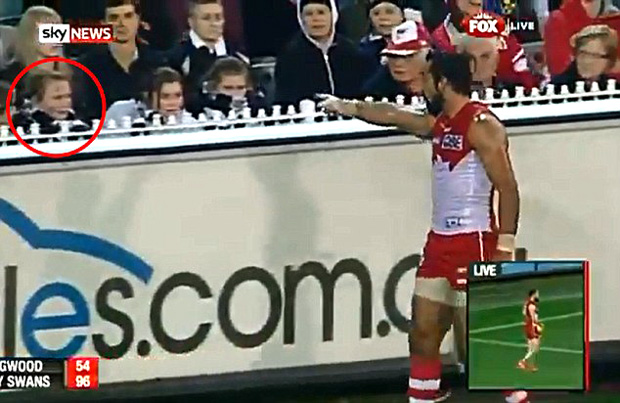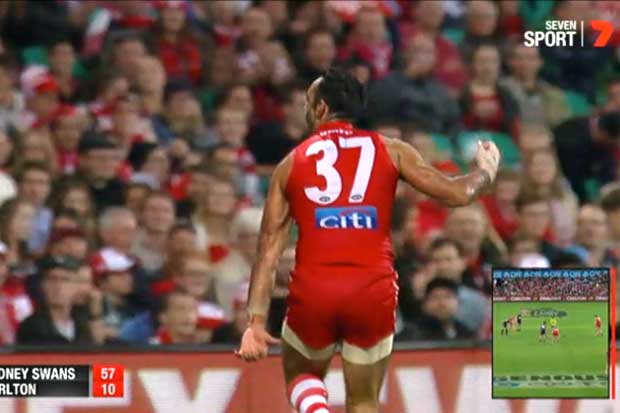In the aftermath of that now famous Ape taunt, Adam Goodes asked a worthy question. Pointing out that his assailant was just a 13-year-old kid he asked, bewildered and obviously hurting, ‘How could that happen?’
He was right to question what we impart to our kids and thereby to point out this is a wider social issue. It sure is.
Since then a series of raceblurts have enshrouded Goodes, from Eddie McGuire’s radio gaff about King Kong, to another spectator demanding he ‘go back to the zoo’.
Emboldened, the Mummy now wants Goodes to apologise to her daughter. These, we should note, are adults, following the lead of a potty-mouthed adolescent. It debases us all.
It also shows the entrenched circuits of racism in Australian public life: its viral nature, its persistence. It shows that racism is most effective when it invokes longheld leitmotifs, breathes life into them anew, and presents an opportunity for prominent racists, such as Alan Jones to publically censor those who defend themselves against it, those who have publicly adopted an anti-racist stance.
What we’re seeing here is a media panic that exposes how racism persists. If we go back to the beginning and trace the Origin or Descent of Ape (with apologies to Darwin), we can come to grips with what that little girl was mouthing.
When the English Buccaneer William Dampier collided with this continent in 1688, he took a dim view of the inhabitants. He called them the ‘miserablest people in the world’ and said, ‘setting aside their shape they differ little from the brutes’. From the very first, Europeans have likened Australian Aborigines to animals.
But this was 325 years ago. Surely we left such attitudes behind. How do they persist so that they are ready-to-hand to a near child in 2014?
Dampier’s words were repeated ad infinitum in a public sphere undergoing dramatic changes, as printing presses took us on our first steps toward the industrialized media scape we inhabit today. In Dampier's time exotic ‘Others’ were imprinted in newspapers through types such as the Barbarian, Heathen, Infidel, Indian or Savage.

The critical thing is, in terms of the persistence, really maintenance, of racism, is that Dampier was quoted again and again even outside the reprints of his own travel journal. His remarks were cited in the rather premature 1787 History of New Holland. They reappeared in an 1854 Dictionary, under ‘Races of Men in Australia’. They found their way into one Albert Calvert’s 1893 Discovery of Australia. They were reprinted 14 times in Australian newspapers between 1890-1948 and also in Walkabout, the widely read tourist magazine, in 1947.
Incredibly, it wasn’t until 1952, that a NSW School Magazine quoted him a little more circumspectly, noting quietly that attitudes have changed since 1688. I wonder.
By the time Cook toured the south seas the ideas of the Swedish botanist Carl Linneas and his classificatory system of taxonomy had well and truly taken root.
In 1758 Linneas set the cat amongst the classificatory pigeons when he ranked humans with monkeys, placing us in the category ‘Primates’. In classifying humans as animals he outraged Christian naturalists by imputing we weren’t made in God’s image. But there was a fall guy, and he was black.
For Linneas had also spurred widespread fascination in the possible link between primates and humans. But it was racially different humans that scientists ranked as closer in gradation to primates.
By the time Darwin’s theory of evolution came along Australian Aborigines were thought to be a special case. They had been fossilized, left outside the loop of evolution, through their long isolation on their island continent. As theories of human origin abounded Australian Aborigines were often believed by zoologists and comparative anatomists to comprise the ‘missing link’ within evolutionary racial taxonomies.
These understandings swept through from the scientific to the popular register. Individual Aborigines were likened to primates through names such as 'Neddy Monkey.'
In the 1920s cartoonists frequently depicted Aboriginal women with Simean features, and pilloried their domestic competency – ironic given how many white women depended on it, but it also justified barely paying them, if at all.
But there were challenges to racial typecasting. As early as 1892 Alan Caroll wrote in the Sydney Quarterly Magazine, “The blacks of Australia have by some been called the ‘missing link’, but this is as absurd as the term, Australian Race, having no foundation in fact.”
The quest to account for racial difference by establishing the origin of ‘species’, had by this time amassed a pile of data which did not prove uniformity within distinct groups, as expected, but instead revealed that human diversity was literally all over the place. Types of teeth, skulls and hair structure were cropping up all over the globe and within all human ‘races’ or populations.
Race traits didn’t belong to any one group at all. ‘Australoid’ skulls were dug up in South America. The attempt to typecaste humans by race eventually capsized under the weight of too much data.
Race as a reliable category of human difference was disproven.
The final nail in the coffin of racial categorisation was the human genome project, which calculated that 85 per cent of human variation occurs within populations and just 3-5 per cent of all human difference can be accounted for by race.
Back in 1951, a fellow named Abbie also discounted key measures of scientific racism in the magazine Oceania. He wrote that aboriginal skulls and skeletons were ‘within the normal range of human variation’; that apes show as ‘wide a range of pigmentation as do humans’: that hair form ‘is a very poor guide to ethnic affinities’; and that brain size, shape or configuration is no basis for the assertion of superiority or inferiority.
All of which would be lost on Alan Jones, who pretends to not to see race as a contrived but determining category. He and Andrew Bolt want to maintain the claim of assimilationists: that the only way to achieve racial equality and eradicate race bias is to eradicate race difference.
What gets thrown out with that particular bathwater is the cultural heritage of Aboriginal identity, which is distinct and should be as equally valued as European heritage.
So Jones argues since other Indigenous AFL players aren’t booed, Goodes is being singled out because spectators don’t like him, irrespective of his race. Actually they quite liked him. (And who are they exactly? Am I seeing things or are AFL fans unusually racially homogenized, that is, a bit of a self-selecting white cohort?)
Aus-priders really like the spectacle of Aboriginal sportsmen until they make their Aboriginality visible. With his imaginary spear, Goodes punctured the notion that the inclusion of Indigenous Australians into public life depends on their successful assimilation, on them resiling from their Aboriginality.
Not Assimilated, Still Blackfella, and Proud, was what Goodes seemed to be communicating – though someone should probably ask him, just to be sure.

What we can learn from the potted history of beastial blackness is how arbitrary and confected meanings of race have always been. But what is startling from our perspective, is just how long these meanings have endured, in spite of being disproved.
Why doesn’t that 13-year-old know Alan Caroll’s name? Why don’t any of us?
It shows that racism persists because of particular inducements. It also shows that racism requires a lot of upkeep. It’s not enough to mouth it once, it needs to be reiterated over and over, it needs a chain of command, and then, finally emboldened, it can be broadcast by the likes of Eddie Maguire, Andrew Bolt and Alan Jones, who from their transmitting vantage give it their imprimatur.
With just one word, from the mouth of a near babe, a long history was invoked in which the very human standing of Aboriginal people was put in question. But when this word erupted from this unlikely unblemished surface, what was she actually saying and why it is still being defended?
In fact, a whole string of derogatory meanings are invoked: that Aboriginal people didn’t know how to cultivate the land, they scavenged hand-to-mouth, so we might as well have it thanks very much – but then set most of it aside for sheep and cows who are far more efficient grazers – or something.
Also meant is the persistent idea that Aboriginal people are lazy and unhygienic: so their kids were better off torn from loving arms, to train, lonely and heartbroken, in homes where they were frequently abused and deprived of the thing that kids most need to thrive – love.
Less discernible but also invoked is the idea that Aboriginal people are great mimics, they could ‘ape’ whites, but underneath they’d never progress to our ‘standard’. Though not as obvious, this particular association is critical, for it goes to the heart of what Aus-priders believe about assimilation.
Goodes made clear that he’s not a prominent Australian on our terms, namely as assimilated. He will not resile from his Aboriginality as Aus-priders would prefer. That’s what they’re booing. They’d rather he drop the ball than make visible that his Aboriginality is indivisible from his achievement.
Aus-priders, Reclaimers, they’re much of a muchness. But they’ve been emboldened since Howard and the ongoing and shameful dependence on wedge politics, not to mention by gormless shockjocks bleating about being silenced by political correctness – through reams of column space, and blaring radio waves. And like they’re not being correct to a politics of their own. Geez.
For all the complex history this is pretty straightforward. Aus-priders, and their more militant guise as Reclaimers, do need to be silenced simply because what they are saying damages people. People already valiantly dealing with intergenerational damage, and like Goodes triumphing. We should be applauding them, they have overcome the adversity of racism.
When the boos start up, AFL players need to rally around their black teammate and drop the ball.
It’s time for each and everyone of us to take any and every opportunity to stare these racists down until they shut-up.
Supporters in the crowd need to turn their backs.
Listeners to Jones and Bolt need to switch off.
With whatever means we have it’s time we call out racist aping, disprove it, turn our backs on it, leave it bleating and blaring into empty space.
Donate To New Matilda
New Matilda is a small, independent media outlet. We survive through reader contributions, and never losing a lawsuit. If you got something from this article, giving something back helps us to continue speaking truth to power. Every little bit counts.




